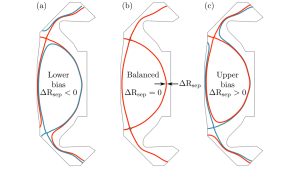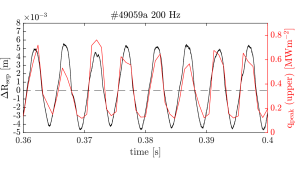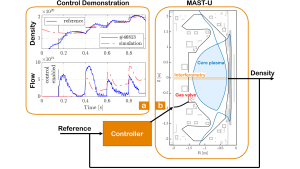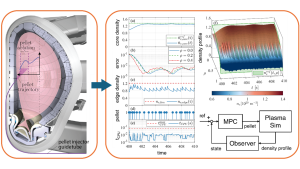Fusion energy could provide clean, limitless electricity, but keeping fusion energy devices stable is incredibly complex. Scientists working on the UK fusion machine MAST Upgrade and at the Dutch research institute DIFFER have made important progress in two key areas
How can we spread the intense heat inside the reactor more evenly? How can we control the amount of fuel in the core? These are some of the questions that arise when we dive deeper into the control strategies necessary for realising fusion as a future energy source.
Experiments of researchers in the UK and the Netherlands show that even tiny shifts in the reactor’s magnetic fields can instantly change where the heat and particles go, which means future reactors will need extremely precise control systems. They also developed smarter ways to manage fuel levels, including using frozen pellets and advanced computer models to keep the reactor running smoothly. Important developments that pave the way for future fusion power plants, like the UK’s STEP and the international ITER project.
 Fig 1: Double-null configuration with a lower-bias (a), balanced (b), and upper bias (c)
Fig 1: Double-null configuration with a lower-bias (a), balanced (b), and upper bias (c)
Power-sharing dynamics
To better distribute the immense power of a nuclear fusion reactor across the vessel wall, an additional divertor can be installed at the top of the machine. This so-called double-null configuration is foreseen for the UK’s STEP fusion power plant, as it directs most of the power to the outer divertors and thereby alleviates the relatively vulnerable inner targets.
Such a configuration is formed by overlapping upper and lower magnetic geometries. When they align closely, balanced power-sharing between the divertors is achieved. However, even a minor misalignment can result in either an upper or lower bias. Maintaining balanced power-sharing is expected to be particularly challenging in future reactors, where the requirements are more stringent than in present-day devices.
Dedicated experiments on MAST Upgrade, conducted in collaboration with DIFFER, have investigated the dynamics of the double-null configuration for the first time. The results were striking: fluctuations in power-sharing were found to directly and immediately affect the divertor target conditions. Even when the power-sharing was modulated up to 200 times per second, the fluctuations appeared at the targets without delay. This implies that there is virtually no time to counteract such imbalances in the divertor; instead, a balanced configuration must be maintained continuously. This represents a major challenge for reactors employing such a configuration and highlights the need for dedicated research in the coming years.¹
 Fig. 2: Upper-outer divertor heat load as a result of a 200 Hz power-sharing perturbation, showing a
Fig. 2: Upper-outer divertor heat load as a result of a 200 Hz power-sharing perturbation, showing a
virtually immediate response.
Core density control
The most promising fusion reaction for energy production on Earth is between two flavours of hydrogen: deuterium and tritium (DT). When they collide with sufficient energy, they fuse and form helium and a neutron. The odds for deuterium and tritium to collide depend on the number of particles that are around. With more fuel in the same volume, we get a denser mixture and more fusion reactions. In this way, the density of fuel in the core reactor volume determines the fusion power production. To control the production of fusion power, we therefore need to control the core fuel density in our reactor.
 Fig 3: (a) On the left, the demonstration of the controller using flow on the gas valve to follow the desired
Fig 3: (a) On the left, the demonstration of the controller using flow on the gas valve to follow the desired
reference density. Offline simulation results are also visible and show that other flows were requested than
expected, exactly why the controller has to act and adjust the flow to be different in order to follow the
reference. (b) On the right, the control loop is visible where laser interferometry measures the core plasma
density of MAST-U and the controller uses this information to adjust the flow through the valve.
The experimental MAST Upgrade reactor started operations in 2020 and has since operated with a core density controller that did not fulfil the needs. This slowed down the physics investigation and device exploitation. Uncontrolled, the core density often rises to levels where global instabilities lead to a sudden loss of plasma (end of experiment). On the lower densities, the plasma legs that go into the divertor of MAST Upgrade split in two, hit sensor windows and trigger protection probes, on which the control system terminates the discharge.
We helped to develop a core density control and apply a sinusoid potential in Volts to the gas valve that injects fuel. Then a laser (interferometer) is used to measure the response of the core density. Using only these measurements (data in the form of rows of numbers), we can measure dynamic behaviour. This data tells us how long it takes for the core density to rise and how much it will rise when we open the gas valve with a certain percentage. With this information, we decide on settings for our cruise control, offline without new experiments. Then, in a third experiment, we demonstrated control by having the cruise-control follow our desired densities; the control loop and experiment results are visible in Fig. 3.²
 Fig. 4: (Left) A cross-section of the ITER tokamak plasma, showing the trajectory of an injected pellet and its ablation approximated as a 1D density profile. (Right) Results from the coupling of the MPC density profile controller (bottom right) to high-fidelity plasma simulations. The controller is capable of tracking the desired density reference (a) without exceeding density limits (c), all within the allowable computation time (e).⁴
Fig. 4: (Left) A cross-section of the ITER tokamak plasma, showing the trajectory of an injected pellet and its ablation approximated as a 1D density profile. (Right) Results from the coupling of the MPC density profile controller (bottom right) to high-fidelity plasma simulations. The controller is capable of tracking the desired density reference (a) without exceeding density limits (c), all within the allowable computation time (e).⁴
The development of density control on MAST-U, as such, has contributed to roughly 20% more successful experiments (that do not terminate unexpectedly).³ They were a necessary step for the development of exhaust control as reported on in an earlier article.
The injection of frozen pellets
For the control of core density on MAST Upgrade, a gas valve was used. However, on a full-scale reactor, the edge of the core is so hot that gas injected at the edge barely influences the core density. Instead, frozen pellets of fuel can be injected that penetrate through the edge into the core, increasing the density there where fusion power is produced.
However, frozen pellets introduce a host of complications with respect to density control. Chief among these is the discrete nature of pellet injection. On the ITER tokamak in France, the largest tokamak in the world now under construction, each frozen DT pellet constitutes at least 6% of the total number of particles in the plasma, meaning each pellet results in a large jump in plasma density when it ablates. These jumps in plasma density can easily exceed plasma edge density limits, which in ITER would lead to an unacceptable plasma disruption and serious damage to the reactor. From a control perspective, the discrete nature of pellet injection also makes real-time control difficult.
 ©shutterstock/agsandrew
©shutterstock/agsandrew
We developed a predictive controller (also known as model predictive control, or MPC) that is able to handle the computational complexity of pellet decisions while preventing the plasma edge density from exceeding allowable limits. To test this controller, we coupled it to high-fidelity simulations of ITER plasma operation, the results of which are given in Fig. 4. This controller demonstration opened several avenues for further improving core density control robustness and computational time, which we hope to implement on other fusion devices with pellet injection systems.⁴
Contributing to the UK programme on Spherical Tokamak for Energy Production (STEP)
All of this comes together in our work for the British public-private project STEP, together with the UK’s UKAEA, which started in February 2022 with the further development of the exhaust control. In 2024, this was followed by developing particle control. We mainly focus on exhaust controllers for STEP that allow for independent, but simultaneous, control of the detachment of the two divertors in a double null configuration, such that heat load is split between the upper and lower divertor.
As this might not always be guaranteed, we also investigate the consequences of disturbances that push all the heat up or down. We also analysed what would be the best set of actuators and sensors to achieve detachment. A key aspect of assessing if the exhaust controller works is to determine what kind of disturbances come from the burning core plasma. Therefore, the size and time-scale of the disturbance have been studied to see which can be suppressed by control and which need to be buffered. We had a particular interest in pellets as they are a predictable source of disturbance which can be suppressed using modern model predictive control techniques.
Both the core control and exhaust control are key aspects in the realisation of nuclear fusion as an energy source, which is significantly sped up by the development of high-field magnetic field tokamaks.
B. Kool, T.M. van den Doel et al., ‘Double-null power-sharing dynamics in MAST-U’ (preprint), Nuclear Fusion (2025).
G.L. Derks et al., Fusion Engineering and Design 202 (2024), 114387
J. Harrison, A. Aboutaleb, S. Ahmed, M. Aljunid, S. Allan, H. Anand, Y. Andrew, L. Appel, A. Ash, J. Ashton, et al., “Overview of physics results from MAST up-grade towards core-pedestal-exhaust integration,” Nuclear Fusion, vol. 64, no. 11, p. 112017, 2024
Orrico, Christopher Anthony, et al. ‘Predictive density profile control with discrete pellets, applied to integrated simulations of ITER’, Nuclear Fusion (2025).
Please note, this article will also appear in the 24th edition of our quarterly publication.

